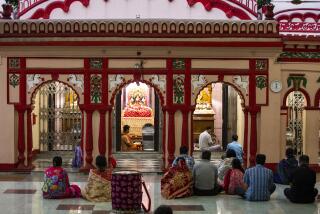Cobra in a Tree Sparks Hindu-Muslim Feud: A Deadly Allegory of Modern India : Religious conflict: The destruction wrought in Hapur illustrates the depths of mistrust. A right-wing chauvinist movement positions itself closer to power.
- Share via
HAPUR, India — Saleem Ahmed was tired of buying and selling manure. The young Muslim wanted a better life for his son and three daughters. So he saved and saved until he had a large enough stake to buy some land--600 square meters of prime development property in this bustling Indian city, his ticket to prosperity and a new future.
Then the snake appeared in his peepul tree.
The riots came soon afterward.
And before the old and blind black cobra managed to escape the Hindu troublemakers who had put it in Ahmed’s tree, nine would die--four from bullets and five from knives--and the old snake would shatter both Ahmed’s dreams and the ancient peace of this north Indian city as well.
The snake in the peepul tree is something of an allegory of modern India, a sign of the times in a crushingly overpopulated nation that has too little land for too many and too much superstition and suspicion against too little education.
And the destruction wrought on this city of 200,000 not long ago illustrates the depth of mistrust between India’s 750 million Hindus and its 100 million Muslims, who have killed each other in record numbers in recent years as a right-wing Hindu-supremacist movement has positioned itself ever closer to power in traditionally secular and socialist India.
Were it not for the deaths and the fear left behind, the story of the snake that materialized one day on the crooked limbs of Ahmed’s tree would have had the makings of a charming new Hindu legend. The people of Hapur were told that the old cobra was a personal emissary of the great Lord Shiva, Hinduism’s god of destruction, and that it had come to say a new temple should be built on the site of the tree.
But in modern India, it seems, such quaint stories are quickly overshadowed by harsh reality.
As it happened, Ahmed, 32, had used his life’s savings to buy that land from a Hindu family just a few months before, and the land stood between a Hindu enclave and an expanding Muslim colony.
Ramesh Kumar Rai, the local police superintendent who prevented the snake riot from becoming a religious holocaust, told this story as Hapur was burying its dead:
“The people who started this riot, they were of the view that if this land was sold to Muslims, they would come into the Hindu areas,” Rai explained. “There was fear among the Hindus that the Muslim community would grow larger and ultimately push them out.”
Such fears are almost universal now among India’s largely illiterate Hindu majority, the result of a successful grass-roots campaign by the Hindu-chauvinist Bharatiya Janata Party (BJP), India’s main opposition force. The party has warned that a soaring birthrate among Muslims will ultimately reverse the nation’s demographics.
Then came the fear of God.
“First, one month ago, they put a photograph of Lord Shiva at the base of that peepul tree, and the people started worshiping there,” Rai continued. The Hindus began negotiating with the Muslims to build a temple on that spot, he said, but the Muslims feared that allowing a temple there could cause trouble in the future.
On Feb. 8, Rai said, the cobra “appeared” in the peepul tree, a variety of fig, and people were told that it had come from Shiva. “We later found it was purchased for 300 rupees ($10.50) from a snake charmer by these mischievous elements.
“People here are very simple,” Rai said, “and their belief in God, their fear of God, it is very strong. They got carried away. People started coming in large groups to see that snake. They started worshiping the snake, offering it money and flowers. Thousands of rupees were collected at the base of that peepul tree.
“Several times, the snake tried to run away, but they would not let it. . . . That snake was so fed up, it tried to jump into the ditch once and escape. But they just kept putting it back in the tree.
Chaman Quereshi is the leader of the Muslim community near the peepul tree. He says that as Hindus began flocking to the tree, fear ran so deep among the Muslims that “we wouldn’t even go near that spot.”
“You see, the main purpose was to keep the Muslims out,” he said. “They fear we will grow in population here in Hapur from our 25% now to a majority someday, and the Hindus wouldn’t be able to intimidate us anymore. And there are some people in the local Hindu community with these BJP feelings. . . .”
For the local Bharatiya Janata Party, the snake in the peepul tree was a masterstroke of political mobilization.
But the national BJP leadership is aware that, in a nation where Muslims often vote as a bloc, it cannot win national power unless it proves that it can protect the Muslims against the very emotions it has aroused in the Hindus.
And that is what Police Superintendent Rai tried to do on the Hindu holy day called Basant Pachimi, the Spring Festival in which the cobra takes center stage.
But by the time Rai deployed his riot squad at the peepul tree on Spring Festival day, it was too late. Thousands of naive Shiva worshipers had gathered and surrounded the tree in a shield of devotion. “The situation had gone way beyond our control,” he said.
The police tried to remove the snake by force. The Hindu organizers responded by positioning women around the tree as a shield. The police fired tear gas. The worshipers responded with stones. Police charged them with canes. The Hindus went to surrounding rooftops and answered with crude bombs and homemade pistols.
“We were cornered,” Rai said in relating a version confirmed by many witnesses. “We did not want to use bullets. . . . But, as I said, we were cornered. So we opened fire. . . .”
The demonstrators resisted until four of their number fell dead, then they fled. As they raced home, many armed with knives, they stabbed five Muslims to death.
As for Ahmed, who did make a tidy profit of 130,000 rupees ($4,550) on his first attempt as a professional property dealer, this will be his last deal. “I had no idea it would cause all this trouble,” he said. “We wanted only to build houses.”
More to Read
Sign up for Essential California
The most important California stories and recommendations in your inbox every morning.
You may occasionally receive promotional content from the Los Angeles Times.













